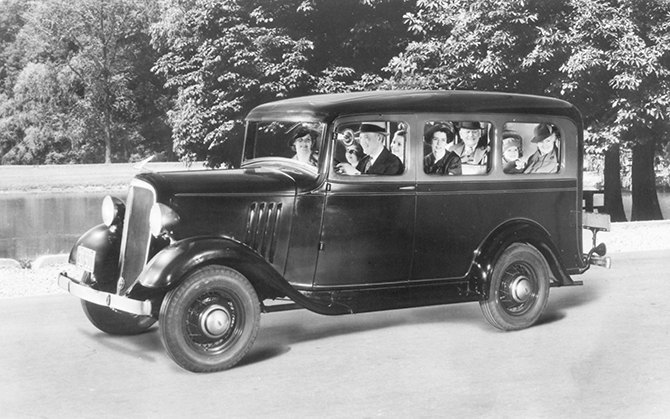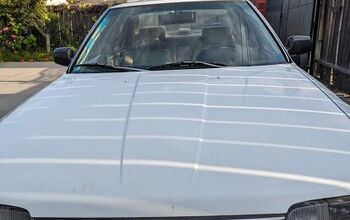GM's Suburbans: Celebrating Seventy Five Years Of Myth And Reality

The Suburban long ago achieved iconic status. It may the most American vehicle ever; in what other country would so many folks drive a vehicle so much larger than necessary? Yes, that’s the uglier side of the Suburban, like my former neighbor who terrorized the neighborhood with her driving antics while babbling unceasingly on her cell phone on the way to her Botox injection appointments. The other side has its roots as a practical hauler of eight or more; a sturdy hybrid of pickup truck and station wagon. The Suburban most perfectly reflects America’s two faces. And which is this one?
If you think the photo above is a real vintage 1935 shot, I have a great deal on Botox for you. It’s a staged and less than convincing attempt at reproducing a scene that wouldn’t have likely ever existed. Families of four didn’t buy Suburbans back then. Their poses are too fake. The patina and useless pup tent are other clues. Most of all, the shiny whitewalls are the obvious giveaway. It’s as realistic as seeing a shiny black new Suburban with big chrome dubs at this lake, or even less so.
This carefully crafted reenactment is designed to sell the the modern SUV myth in a historical context: that for 75 years, the Suburban has been the key to escape from the hum drum of suburban life. Never mind that 99% percent of them will never leave the pavement. And how many will actually ever leave suburbia?
The truth is that’s not how Suburbans were typically sold or used in 1935. The Suburban was a true utility vehicle, for hauling large groups of folks or cargo, most typically in a commercial setting. Families bought sedans.
My apologies to those that already know this, but the origins of the station wagon were the horse-drawn wagons that hotels sent down to the train station to pick up arriving guests. Or more accurately, to compete for them. And of course, they evolved into the well loved woody station wagons of the horseless era. The Suburban was nothing new; it was just Chevy’s station wagon of the era, with a new name. And the picture above this one reflects how they were typically used, not the lakeside one.
Enough of the history and myths. Chevrolet (like most other manufacturers) didn’t offer a distinct passenger car-based station wagon until 1939. The Suburban was just the latest in the line of station wagons based on the commercial/light truck version of Chevrolet chassis. But the new name was concocted in 1935, probably the result of GM’s nascent marketing department of the time. And that’s what we’re celebrating: a new name on an old idea.
The first Suburban generation went through 1940. This 1942 was its successor, and carries the chrome grille and trim of the last pre-war model.
The Suburban was put to good use in WW2, like everything else practical and useful made at the time. Perhaps a Suburban historian can explain why these two similar vintage trucks have different rear bodies? The upper one has more side windows. Probably it was a custom job, and not the standard factory body. Woodies were also available in this period.
The new Chevy trucks that arrived in 1947 were the cat’s meow: handsome, roomier, more comfortable. And the Suburban was the hard-working jack of all trades that could haul cargo, human or otherwise.
Its timeless good looks have made it a favorite with restorers, and of course, it inspired Chevy’s HHR.
Chevy went for a double hit with its successor in 1955. Especially the first couple of years with the single headlights and tasteful eggcrate grille are about as good looking of trucks of this vintage for sure.
We’ve covered the 1959 – 1966 generation in today’s Curbside Classic. They were the last to ride on the shorter wheelbase and have only two passenger doors.
And its successor is also featured in today’s other CC. The longer 1967 – 1972 generation had three doors to facilitate entry to the rear.
The next generation was the definitive modern Suburban. It was built practically forever, from 1973 through 1991, by which time it was a rolling dinosaur. The optional wood grain vinyl on the side of this one speaks to the role the Suburban was now increasingly finding itself in. The SUV era snuck up on us, and before we knew it, the Suburban had become the official soccer-mommy-mobile of Texas. A business trip to Huston in the early eighties confirmed it: the soccer field next to my hotel had a long line of these all in a row: I had never seen anything like it. The future was here.
The Suburban was a rolling celebration of that state’s primary product: cheap oil. In Texas the stuff is available for the picking, right on the beach even.
GM finally saw fit to bestow a new Suburban in 1992. Why did it take so long? The old version sold so well, they just didn’t want to spend the bucks, even though this generation of pickups had been out for years. But it was worth the wait! It was a fairly handsome beast, in the clean idiom of eighties GM styling. And by now the transformation into one of GM’s most successful cash cows was complete: the interior was as plush as the plushest GM sedans. All vestiges of old truckiness was rinsed away. And the soccer mommies loved it more than ever.
2000 ushered in a new GM truck chassis and a new Suburban to sit on it. This is the beast that my neighbor scared us all with. She literally would drive down the wrong side of the street. One time I followed her to the free way, and she drove for about a mile with over one half of her big dark blue Suburban in the shoulder. Most folks have a hard time muti-tasking, but some just shouldn’t try. And why do they drive big tanks like this?
The home stretch. I think its wonderful that the Suburban exists. Undoubtedly, there are a handful of folks out there that put them to good use. But then just a couple of days ago, I was at Lowes, and a big, shiny new black Suburban (or was it a Denali?) like this pulled up next to me, and a suburban family of four tumbled out; cheerful, well dressed, and all of them grossly overweight. And I thought to myself: what is this country America, and why do I have these moments where I feel like a freshly arrived foreigner in awe and confusion? After fifty years here, you’d think I wouldn’t still have experiences like that. Oh well; maybe I’ll get it and the Suburban eventually. Happy 75th Birthday, Suburban! Will you make it to 100?

More by Paul Niedermeyer
Latest Car Reviews
Read moreLatest Product Reviews
Read moreRecent Comments
- SCE to AUX Norway is in Europe, and Tesla is an American automaker - no problems there.I wouldn't use Ford as the bellwether.https://www.reuters.com/business/autos-transportation/tesla-extends-lead-norway-evs-take-record-82-market-share-2024-01-02/https://elbil.no/english/norwegian-ev-policy/
- Steve Biro If the U.S. government wants to talk about banning all connected cars - or at least the collection and sharing of information from said vehicles - I’m all ears. Otherwise, don’t waste my time.
- Ajla Both parties are in favor of banning Chinese vehicles so I don't see how it won't happen in the next year.
- Add Lightness I don't waste a lot of time watching nothing much happening by watching the YouTube 6 minute highlights.
- MrIcky from my rental fleet experience, id rather drive one of these than a camry.















































Comments
Join the conversation
Although they may be difficult to justify in most situations, in a perfect world they are the right vehicle.
I like them up to and including 1955 gen. I really like them. These are potential lifetime projects, like a small inboard Chris Craft or Piper Cub, to me. After that ugly and/or worse although durability and longevity probably improved. If you need one for its utility, then fine, OK. No problem. Admit space and ground clearance is available. I got a ride in 1980s version in surburan Boston a while back. Owned by a 5"2 healthy fit intelligent professional European woman with normal Boston husband and no kids or boats or anything. Hideous wallowing lumbering rattletrap slow thirsty s**tbox when used as a car. May I mention the injection molded interior where not a single fastener was properly installed at the factory? And the rust? It was the only really stupid thing she was doing in her life that I knew about. She admitted it. I knew people who bought them for the fantasy, imagining they would become outdoorsy types (refer to my Chris Craft dream.) Hard to sell. This was in early 80s. Then I knew people who profited during the late 80s SUV boom, buy and drive for couple years then sell.